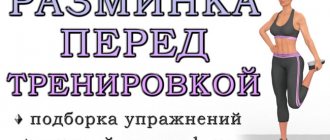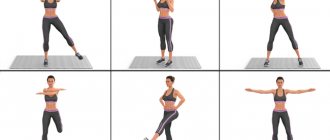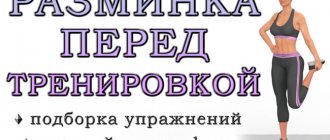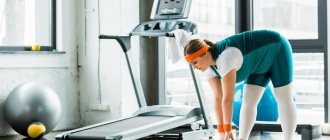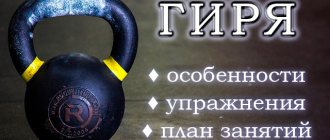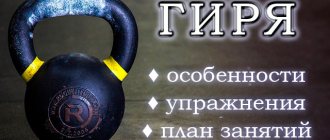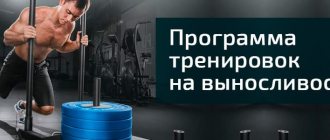© AndrewLozovyi — depositphotos.com
Share:
Not all beginners understand that warming up before training is an integral part of the training process. By taking this rule as a basis, you will protect yourself from many unnecessary injuries, maintain athletic longevity and increase the benefits of working out in the gym. In this article we will figure out how to properly warm up before training and why it is necessary.
The benefits of warming up before exercise
Dynamic warm-up for the average athlete lasts no more than 5-10 minutes. It would seem, what could happen in such a short time? In reality, a lot is happening - let’s look at all the positive consequences.
Warming up the entire articular-ligamentous apparatus
If you go to the gym after work or school, never skip the warm-up. You likely haven't had much physical activity throughout the day. During this time, all the ligaments have lost their elasticity; they are literally stretched like ropes. If they are not properly warmed up, the risk of sprained or torn ligaments increases.
It's the same with joints. The goal of any joint gymnastics or light strength warm-up with light weights is to increase the synthesis of joint lubrication. If you don't do this, in the long term you increase the likelihood of developing arthritis or arthrosis.
Preparing the cardiovascular system for stress
The heart is the most important muscle in the body of any athlete. Without a healthy heart, not only progress in sports is impossible, but also an active lifestyle in general. At rest, the heart rate of an adult is 60-80 beats per minute. With active load it increases to 140-170 beats.
If you avoid warming up, your heart feels like it jumps from first gear in a car straight to fifth. This leads to hypertrophy of the heart muscle. In the medical community, this is usually called “athletic heart syndrome.” Sometimes this passes without consequences, but is often accompanied by arrhythmia, tachycardia and hypertension. Your heart rate should increase consistently, which is why proper warm-up before training is important.
Warming up the muscles
Fitness, crossfit or bodybuilding classes are impossible without neuromuscular connections. A 10-minute warm-up will help you feel how your muscle fibers stretch and contract. Then the training will be more productive: you will feel the work of the muscles, and not the joints and ligaments. Without this, a full set of muscle mass is impossible.
Plus, you reduce the chance of injury. In professional strength sports, a tear or tear is quite common. The most common reason is lack of warm-up. This happens because unstretched and “cold” muscles are more susceptible to cramps and spasms. When an athlete attempts to lift a weight without warming up, the muscle fibers become stretched or torn. Most often this happens to the pectoral muscles and inner thighs.
© Vadymvdrobot — depositphotos.com
Mental preparation
Psychology in sports is the most important part of the training and competitive process. Do you plan to have a record in the deadlift or bench press? Installing it (and simply working with heavy weights) will be almost impossible, and even extremely dangerous without performing warm-up approaches. After some light cardio and joint warm-up, take an empty bar and start performing the exercise with it. Each repetition should be slow and controlled - constantly feel the muscles working. Gradually increase the weight of the weight. This way you will mentally tune in to your maximum result.
Smooth increase in body temperature
During intense exercise, your body temperature rises. This is an absolutely natural process. The purpose of warming up is to start thermoregulation processes, then you will feel comfortable exercising and your health will not worsen. Warm up until light sweat appears on your forehead, this is a kind of indicator that your body is ready for exercise.
Found 285 9 letter words
If you don't find the right word, try entering your question from the crossword puzzle, enter the required number of letters and click the solve button, with this you will narrow down your search.
- what if
- a cappella
- what about you
- as well as
- and there too
- what about
- lampshaded
- lampshade
- abbess
- abbatial
- abbey
- Abwehr member
- aberration
- abiogenesis
- abiogenic
- Abyssinian
- Abyssinian
- Abyssinians
- subscription
- aborigines
- apricot
- apricotine
- absolutely
- absorbent
- absorption
- absurd
- Abkhazian
- advance
- proscenium
- avant-garde
- aventurine
- adventurous
- emergency
- emergency worker
- air ticket
- air bomb
- airline
- aircraft
- aircraft engine
- aircraft carrier
- airmail
- air show
- airsports
- air unit
- flying school
- emergency
- Australia
- Austrian
- Austrians
- bus
- by bus
- caravan
- aerial platform
- autogamy
- auto race
- auto racing
- car plant
- auto shop
- autonomy
- offline
- autopilot
- road train
- rally
- authority
- copyright
- author's
- authorship
- pen
- car showroom
- motorsport
- autotype
- tractor unit
- autochthons
- agar-agar
- agent
- agency
- propaganda point
- agglomerate
- aggressors
- agronomy
- agricultural physicist
- agrochemist
- agrochemistry
- Agulsky
- adaptation
- Adventism
- Adventist
- adequately
- Adjarian
- adaptation
- adrenalin
- address
- adsorbent
- adsorption
- delicacy
- Asiatic
- Asian
- azimuth
- nitrous
- Aysorian
- aba
- Abalakovs
- Abyssinia
- abo (abo)
- Abramtsevo
- Augustals
- Averroism
- autowaves
- self-timer
- autosling
- agamemnon
- agjabedi
- agloporite
- adelheim
- aznakaevo
- aisha bibi
- akanishtha
- acantharia
- acarnania
- aquilegia
- ak-mosque
- axolotl
- actinidia
- actualism
- actuary
- ak-shyirak
- Alapaevsk
- Alash-Orda
- Algonquins
- Alexander
- allantoin
- Allah-yun
- Allobroges
- allochthons
- albatross
- albumins
- alveolitis
- alhambra
- aldehydes
- almandine
- Almohads
- Alperov's
- mountaineering
- alpha (a)
- gigolo i
- aluminates
- aluminum gel
- amagasaki
- amaravati
- amaryllis
- Amaterasu
- amatsumara
- Ambystoma
- amebocytes
- Americana
- amyloidosis
- ammonia
- ampere hour
- amt
- amphibolite
- amphisbaena
- analgesia
- anachromat
- anhydrides
- andalusite
- Andamanese
- androgens
- Andromache
- Andromeda
- annalists
- Anopheles
- anteclise
- antihero
- antigorite
- anticodon
- antinovel
- Antichrist
- Antonovka
- anthocyanins
- ahnfelcia
- Apimondia
- apo (apo)
- apocrisis
- aponeurosis
- April
- testing
- Apsheronsk
- arabinose
- araucaria
- arboretum
- Centurion
- Westville
- Sunnyside
- Malmesbury
- Balaclava
- Libreville
- Pittsburgh
- Brattleboro
- McKinney
- Round Rock
- Branchburg
- Williston
- Saddle Brook
- San Diego
- Uniondale
- Providence
- North Bend
- Clearwater
- Fort Payne
- South Bend
- Urbandale
- Evansville
- Naperville
- Bridgeport
- Fort Worth
- Frankfort
- Warrenton
- Arlington
- Winchester
- Birmingham
- Fayetteville
- Waikarusa
- Greenville
- St. Louis
- Henderson
- Winnebago
- Espanola
- Red Bluff
- Lovington
- Chillicothe
- Baton Rouge
- Gainesville
- Fort Smith
- Weatherford
- Greeneville
- Dodge City
- Mabelvale
- Lewisville
- Horn Lake
- Charleston
- Lancaster
- Midlothian
- Sunnyvale
- Hollister
- Pescadero
- Cupertino
- Corsegold
- Davisburg
- Waterloo
- Perryville
- Manchester
- Batesville
- Allentown
- Grapevine
- Woodinville
- Las Vegas
- Bourbonnais
- Bremerton
- Richardson
- Riverside
- Covington
- Los Gatos
- Camarillo
- Pleasanton
- Swedesboro
- Trussville
- Tuscaloosa
- Scottsboro
- Escondido
- Encinitas
- Calexico
- Santa Ana
- Fort Wayne
- Billerica
- Fort Mill
- Tonawanda
- Plainfield
- Chelmsford
- Annapolis
- Cockeysville
- Burnsville
- Lindstrom
- Greensboro
- Fort Pierce
- Davenport
What are the dangers of not warming up?
By not warming up, you increase the likelihood of injury. In power sports, this causes at least half of the damage. The most common problem among athletes of any level of training is sprained ligaments. This injury plagues athletes from many sports: crossfit, powerlifting, martial arts, football, etc. During the warm-up, your ligaments become more elastic and better absorb the force load.
Joint injuries are slightly less common. The most affected areas are the knees, elbows, hands and shoulder joints. Spending 10 minutes doing rotational exercises, low-weight assistance exercises, stretching, and a couple of warm-up sets with an empty bar or light dumbbells will reduce your risk of injury to almost nothing.
Any injuries always mean a stop in progress, a break in training for up to several months and a rollback of existing results. One wrong action or careless movement can throw you out of your usual rut for six months.
In the long term, not warming up has a negative impact on your cardiovascular health. The heart is also a muscle, and it needs to be trained. You just need to do this smoothly and gradually, so a light cardio warm-up is an integral part of any well-structured training program.
Stretching
Everyone can be flexible if they work at it. Some people have a natural gift for flexibility, others must fight to get every little bit of success. And at the same time, everyone can achieve flexibility. This requires persistence and regular training, and the muscles gradually adapt and react in response.
The best time to stretch is after a workout, when our muscles are completely relaxed, fully warmed up and capable of the slightest stretch. When muscles are really well warmed up, they exhibit a high degree of plasticity. This means that they not only stretch, but after stretching and cooling down they maintain an increased range and exhibit greater flexibility.
Here's the reason why everyone should stretch: range (or range) of motion. Whether you're a boxer or a ballerina, your sport requires your muscles to perform different movements. Muscles that are tense and compressed tend to work against each other to perform a movement. This means that the energy that should be used in the movement itself is actually absorbed by the struggle against the muscles themselves and their supporting groups. It sucks energy.
Warm-up structure before training in the gym
First of all, do a little joint exercises. It does not take a lot of time. Perform rotational movements, turns in different directions and similar movements. We recommend starting from top to bottom and warming up in approximately this order:
- cervical spine;
- shoulder joints;
- thoracic spine;
- elbow joint and hands;
- lumbar spine;
- knees;
- ankle and calves.
Choose one or two movements that you are comfortable doing. Perform 20-30 repetitions of each. This will warm up your joints and ligaments and protect them from damage during heavier work. Stick to an average pace; there should be no sudden or jerky movements. Approximate time for performing the joint gymnastics complex: 3-5 minutes.
Stretching
As the next step, we recommend a small stretching routine. We need to statically stretch each muscle group. This mobilizes muscle tissue, stretches fascia, and stimulates blood and oxygen flow to cells. There is no need to stretch for a long time; it is enough to linger at the point of maximum tension for about 15 seconds.
Start doing it the same way – from top to bottom. Pay special attention to the pectoral muscles, latissimus dorsi, spinal extensors, hamstrings, and hip adductors. This way you will prepare your muscles for the power load, protect yourself from injury and you will better feel the contraction and stretching of the muscles in each repetition.
To stretch all the back muscles, a regular hang on the bar is suitable. The most comfortable way to stretch the pectoral muscles is by leaning one hand on the squat rack and leaning your whole body forward. To stretch your lower back and hamstrings, use hyperextensions and straight-legged forward bends. Approximate stretching time: 3 minutes.
© HayDmitriy — depositphotos.com
Cardio
The next step is to do some light cardio. Your task is to prepare the cardiovascular system for stress. Do light aerobic exercise with a heart rate of up to 130 beats per minute. This is the average heart rate at which the processes of lipolysis (oxidation of adipose tissue) are launched. Walking on a treadmill, exercise bike, stepper or ellipse is ideal for these purposes. When you feel that your body temperature has increased slightly, you can finish. Five minutes should be enough to warm up properly.
Warm clothes help to warm up well. Warm up with a sweatshirt on and then take it off during exercise. This will raise your body temperature faster and save you some time.
© Syda_Productions — depositphotos.com
Strength exercises without weights
The final stage of the warm-up before training in the gym will be to perform CrossFit strength exercises with light weights. They will help you feel the muscles working properly and improve blood circulation in them. This results in a slight variation of pre-fatigue.
Pay special attention to exercises for those muscle groups that you are training today. Shoulder day? Perform 3 sets of side and front swings with the lightest dumbbells you have in your gym. Heavy squat ahead? Do three sets of bodyweight squats. Approximate time to complete the complex: 5-7 minutes. Rest for a couple of minutes and start your main workout.
© undrey — depositphotos.com
We have given an approximate warm-up complex for the whole body before training in the gym. If you are limited in time, one or two stages can be removed from it - this is not critical.
Charging for children's fingers
Schoolchildren experience great stress on their hands due to the fact that they have to write a lot. Warming up your hands and fingers for children will help relieve fatigue. The following exercises are useful for schoolchildren:
- "Cockerel." Clasping your palms, press with one hand on the back of the other. When you straighten your palms, you get a figure that resembles the comb of a rooster.
- "Track". Take turns placing fingers of the same name one on top of the other, nails down, as if walking along the road.
- "Centipede." Use your fingers to move to the opposite edge of the table, taking small steps.
- "Elephant". Place all fingers on the table except the middle one, which is extended forward - this is the trunk. Use four fingers to move, as if using feet, slowly moving along the surface.
- "Lanterns." Clench and unclench your palm, spreading your fingers wide.
- "Dough". Make movements with your hands as if kneading dough.
To make it more interesting for the child to practice, hand warm-ups for children can be accompanied by rhymes.
Taking breaks during the workday to do simple exercises can help prevent your arms from feeling tired in the evening. Warming up your hands helps maintain their beauty, is good for joint health, and improves skin condition. Gymnastics will protect those who work at the computer from the development of tunnel syndrome, which occurs due to pinching of nerves and is manifested by pain. And for children who have just started school, exercises will help them quickly get used to new loads and prepare for writing.
Home workout complex
Warming up before working out at home will be a little different. You can remove the cardio load from it, since any home workouts do not involve the same intensity as training in the gym, and only slightly increase your heart rate. However, you can safely replace walking on a treadmill with running in place or a couple of rounds of “shadow boxing” (imitation of boxing sparring with an imaginary opponent). This will only be beneficial. Cardio can be replaced with full-body warm-up exercises, such as Jumping Jack (jumping while clapping overhead) or squats and throwing a ball against a wall.
If time is short, do a short warm-up before training - limit yourself to joint exercises and stretching. These are the two most important components. However, be sure to gradually increase the working weights in the basic movements, otherwise you risk injury.
An important principle of warming up is not to overdo it. You should not feel tired: on the contrary, proper warm-up adds strength and vigor.
The more experience you have, the longer the warm-up should be. Your muscles are stronger than those of beginners, you lift heavier weights and train more intensely. Therefore, it takes more time to tone all body systems. Don’t be lazy: your athletic longevity and progress largely depend on warming up.
There are no fundamental differences between warming up before training for men and girls. However, in most cases, men take longer because their training is more intense.
Warm-up exercises before training
The first stage of the warm-up is to tone all joints and ligaments. There is nothing complicated here: perform rotational movements, turns and tilts in each direction. Start at the neck and work your way down to the ankle. 20-30 repetitions will be enough. When stretching your neck, it is better to do without rotational movements. The cervical spine is the most fragile, and any sudden movement is fraught with potential danger. Pay special attention to warming up the rotator cuff of the shoulder joint. Perform swing movements in different planes: to the sides, up, back, etc. The more there are, the better. The main thing is to take your time and do not make sudden movements.
With the stretching complex, everything is also simple. This is not just about splits; every muscle group can and should be stretched. The benefits of stretching are enormous; it is an essential part of the training process for athletes from any discipline. The main principle of proper stretching: you should feel muscle tension, not pain. There shouldn't be any discomfort.
Then we begin to perform cardio exercise. We warm up a little and move on to strength exercises. Here our task is to isolate the working muscle groups as much as possible and load them. That is why isolated exercises are suitable for a general warm-up, and not, for example, deadlifts.
| Muscle group | Warm-up exercises | Number of approaches and repetitions |
| Neck | Lying neck curls with a disc on the forehead or back of the head | 2 x 20 |
| Shoulders | Swings with dumbbells to the sides or in front of you while standing. Row of the barbell to the chin with a wide grip. | 2 x 25 |
| Breast | Hand raises in crossover Push-ups | 3 x 20 |
| Back | Wide grip pull-ups Wide grip lat row Hyperextension | 2 x 15 |
| Hands | Arm extensions from the upper pulley with a cable handle Biceps curls from the lower pulley with an EZ handle | 3 x 20 |
| Press | Crunches while sitting in a machine | 2 x 25 |
| Legs | Leg extensions while sitting in a machine Leg curls while sitting in a machine Leg curls while sitting in the exercise machine Bodyweight squats | 3 x 20 |
All exercises are performed with minimal weight. Your goal is not to fill your muscles with blood as much as possible and reach failure; you just need to “wake up” your body and prepare it for a heavier load.
Summary
Warm-ups are the very “salt and pepper” that distinguish training from the boring “systematization and generalization of ideas about the subject”, turning it into an interesting, exciting and memorable event, where new ideas are born and you don’t want to sleep at all. It helps to talk about boring things in an interesting way and starts the necessary process:
- promotes a safe, open atmosphere;
- brings together participants;
- creates or activates the group's focus of attention;
- involves in action;
- increases communication;
- increases performance;
- involves creative or analytical thinking;
- relieves mental and physical stress;
- calms or invigorates;
- helps cope with resistance.
Ultimately, warming up contributes to a more productive assimilation of educational material, thereby increasing the effectiveness of the training.
